

Prospects for Quebec's Food and Beverage Industry
Tea and Coffee Industry
May 2001
Question? Comments?
Agriculture and Agri-Food Canada
Markets and Industry Services Branch (Quebec)
2001, rue University, Pièce 746-M
Montreal (Quebec) H3A 3N2
Tel: (514) 283-8888
Fax: (514) 496-3966
We would like to thank the Business Support Directorate of the Quebec Department of Agriculture, Fisheries and Food (MAPAQ) for their contribution to improving this document.
1.0 Quebec's Food and Beverage Industry
Largest Manufacturing Industry in Quebec
Agri-food activities, from harvesting resources to delivering foods and beverages to consumers, constitute one of the cornerstones of the Quebec economy, accounting for close to 12% of all jobs, or over 400,000, and injecting close to $12.4 billion each year into the Quebec economy, or 8% of the Gross Domestic Product (GDP).
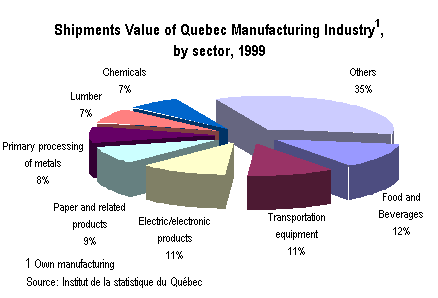
With shipments of $13.8 billion in 1999, the food and beverage industry 2 was the province's largest manufacturing sector, representing 12% of all processing in Quebec. Food and beverage processing alone generates $5 billion each year in added value and 55,700 direct jobs in the economy. The Quebec industry accounts for 25% of food and beverage jobs in Canada and 25% of value added 3 .
Quebec's geographic location, at the centre of a market of 100 million consumers living within 1,000 km, gives the industry here a tremendous advantage. The Quebec industry also benefits from an excellent multimodal transportation infrastructure that allows it to supply not just the large urban centres of the northeast but international markets, as well.
1.1 Manufacturing Shipments
A Booming, Diversified Industry
The Quebec food and beverage industry is highly diversified. The dairy industry is the largest sector, accounting for 28% of all food and beverage manufacturing shipments in Quebec for 1999. The red meat industry, chiefly pork, ranks second, with 21% of shipments, followed by animal feeds, with 9%.
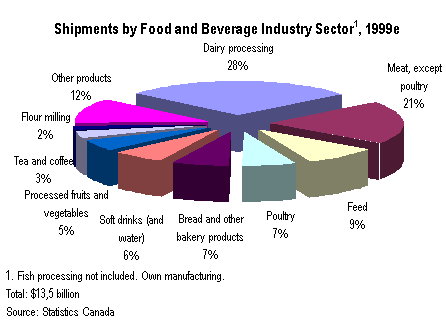
The food and beverage industry has enjoyed strong growth over the last three years, largely due to the great strides made by the confectionery/chocolate and soft drink sectors. Between 1998 and 1999, total growth amounted to more than $570 million.

1.2 Supply and demand 4
The food and beverage industry has certainly benefited from the growth in the Canadian market5. Overall demand increased by 18% between 1994 and 1999, for a mean annual growth of 3.7%. Sectors in which growth in demand was particularly strong over the period are wines (11.2%), confectionery and chocolate (6.9%), flour milling (6.6%), vegetable oils (6%) and poultry products (6%). Between 1994 and 1999, the Canadian beverage market saw higher mean annual growth than the food market (4.9% as opposed to 3.5%).
The industry benefited most of all from a 86% growth in exports between 1994 and 1999. Despite the unfavourable economic conditions of 1997 and 1998, Quebec agri-food exports held steady at about $2.5 billion. The weaker growth in imports (18%) enabled Quebec to improve its agri-food balance of trade appreciably over this period, achieving a slight surplus in 1998 and 1999.
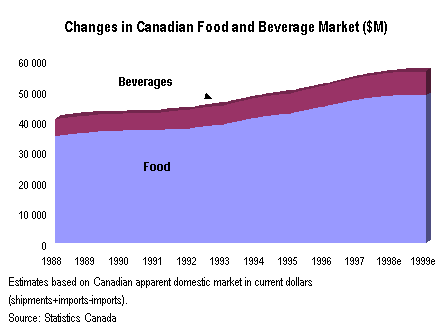
The United States is still the main trading partner of the Quebec food and beverage industry, accounting for 71% of sales, or $1.8 billion. Quebec purchases are more diversified, however, thus making its supplies less dependent on the value of the U.S. dollar. This contrasts with Canada as a whole, for which the United States accounts for almost two thirds of all agri-food trade (imports and exports). Quebec has therefore enjoyed a greater advantage from the weakening of the euro than has the rest of Canada.
Among Quebec's other trading partners, the European Union ranks second as a destination for our agri-food products, receiving 7.5% of trade, while Japan is the destination of 4.6% of our exports. It is worth noting that despite the North American Free Trade Agreement (NAFTA), Quebec exports only $11.5 million worth of agri-food products to Mexico, amounting to a mere 2% of Canadian exports to that country.
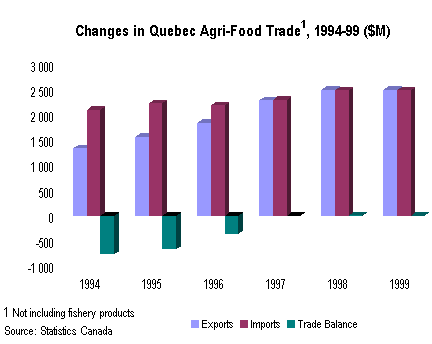
Quebec also diverges from the Canadian average in terms of the type of exported products: 36% of agri-food products exported by Quebec are consumer products, in contrast with the Canadian mean of 5%.

2.0 Tea and Coffee Industry
The Quebec tea and coffee industry is the eighth largest manufacturing branch of the food and beverage sector, with $378 million worth of manufacturing shipments in 1999, up 31% from 1994 6. The size of the industry, which employs 716 people (1997 data), is all the more remarkable given that supplies of raw materials come entirely from abroad. The $200 million in added value in 1997 illustrates how dynamic the coffee roasting and marketing branch is in Quebec.
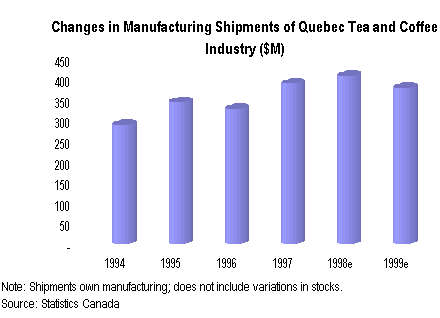
The variations in manufacturing shipments in the Quebec tea and coffee industry reflect fluctuations in the prices of the commodities on international markets. Overall consumption is fairly stable, so annual variations of 5-10% in world production cause sharp price swings. Frost, which hit the big coffee-producing areas of Brazil in 1994, led to a significant hike in prices, which in turn had an impact on the value of shipments from 1994 to 1997. The shift in demand to speciality products with greater added value explains the upward trend in shipments.
2.1 Markets and Supplies
Canadian coffee consumption has remained fairly stable for several years, at about 4.5 kg per capita. Consumer demand, however, has gradually been shifting toward better-grade roasted coffee, sold as whole beans or freshly ground, and away from packaged preground or instant coffee.
In the U.S., per-capita coffee consumption fell significantly between 1975 and 1995, both of instant (-38%) and regular (-34%) 7. More recently, according to another source, sales of instant coffee declined by an average of 1.8% per year from 1996 to 1998 and should continue to slide by more than 1.5% per year until 2002 8. In contrast, sales of whole coffee beans should continue to grow by 3% per year on average over the same period, given the craze for specialty coffees. These forecasts point to a slowdown in the growth the product has enjoyed since 1994 (average annual growth of 6.3% between 1994 and 1998), due essentially to competition from soft drinks and sports drinks, as well as to major price fluctuations during that period.
Coffee, which was traditionally drunk at home in the morning, has now become a firmly established part of daily life, work and leisure. The rapid development of coffee houses, coffee bars and specialty shops has helped cultivate consumers' taste for gourmet coffee. Yet total Canadian demand has increased only slightly, as one product has been substituted for another. In terms of value, however, the Canadian market's growth still partially depends on fluctuations in the world price of coffee. But by integrating their operations and adding greater value to products and services, industry players are now better able to manage their profit margins and can avoid having to pass on to consumers too quickly the sudden fluctuations in the costs of their supplies.
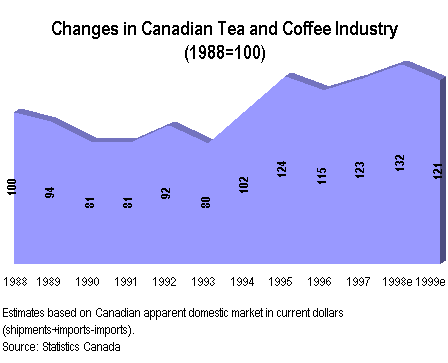
Broader Concerns
The suspension in 1989 of the international agreement governing the coffee market, which was based on an export quota system, forced the main producing countries to regroup as the Association of Coffee Producing Countries (ACPC) 9. Its members had agreed to initiate an export program and implement the Coffee Retention Plan, the main goal of which was to curb the volatility of the price of green coffee on the market, and thus stimulate a price recovery. Prices had dropped by more than half from their 1997 peak 10. A number of factors, including the failure of most producing countries to participate in the plan, the large world supplies and the favourable temperatures in the southern hemisphere, combined to keep the price of arabica coffee at levels that had not been seen since 1993 11. But these low prices do not serve the interests of the industry as a whole over the long term. The producing countries are under pressure from developed countries to take steps to ensure sustainable development. Better quality is also being demanded on the world market. If producers are to progress in that direction, they must receive the right signals from the market and they must be compensated satisfactorily. Contractual agreements and producer-processor partnerships are now being developed to try to meet their mutual needs for improved quality, production techniques and profitability. In many cases, buyers are paying well above world prices. For the premium coffees most in demand, new sales methods now rely on auctions, either physically in the countries themselves or over the Internet. In such cases, the effect of limited supply combined with increasing demand is forcing buyers to pay ever-higher prices.
Tea: A Hot Market
Tea has been gaining in popularity since 1992, when the continuing downward trend was reversed (low point of 0.54 kg per person). Tea consumption has been climbing since then, reaching 0.80 kg per person in 1988. The market for premium teas and herbal teas (or tisanes) has grown remarkably 12. Specialty teas, sold in teabags in fancy packaging, and green teas are behind the growth in tea consumption in this country. The emergence of new places to drink them, such as tea rooms and coffee houses, has also expanded both the range of products on offer and the customer base. The industry's chief characteristic is its high added value, because the raw material actually accounts for only about 10% of production costs. Overall, sales of hot tea and iced tea are growing, and reached $267.5 M in 1999 in Canada 13. Sales of teabags grew by 5%, to $152 M. Sales of black tea accounted for 76% of teabag sales and rose only 2%, while sales of fine teas leaped 21%. Green tea enjoyed quite a fad as sales jumped 54% to reach $4 M. Sales of canned ice tea also rose, to $34 M, up 15% over 1998. In Quebec, the three segments with the strongest growth in 1999 were black specialty teas (+41%), iced tea (+31%) and green tea (+16%). Interestingly, the change in consumer habits is partially attributable to the health benefits associated with the drinking of tea and herbal tea. Scientific research appears to show that green tea and black tea contain antioxidants that may help prevent heart disease and some types of cancer.
TRANSHERB e and Leika Foods are interesting examples of dynamic, successful companies in this field. Over the years, they have developed lines of teas and herbal teas that have become very popular with consumers both here in Canada and abroad.
Expertise and New Products
New consumer trends that favour better coffees are forcing producing countries to refocus their output to satisfy world demand for both quantity and quality. Recent concerns about fair-trade coffee 14 are also part of a response to this new reality. Since the fall of 2000, Van Houtte has been distributing coffee certified fair trade and organic. Since October 2000, Starbucks, the world leader, has been supplying Fair Trade Certified Coffee to its 2,300 outlets in the U.S., after reaching an agreement with TransFair USA, an accredited independent certification organization. Meeting consumers' increasing demands today means using leading-edge roasting equipment and developing new blends. The problem of preserving roasted coffee in sales outlets has been partially solved, thanks to vacuum packaging with a valve that helps keep the product fresh. For sales to consumers who wish to blend their own, improvements to display cases in supermarkets now prevent beans from leaving oil residue on the glass, enhancing both freshness and consumers' perception of the coffee.
The response of Kraft Canada (under the brand name General Foods International Coffees) and Nestlé (Nescafé) to shifts in consumer preference to specialty coffees has been to position mainly instant-coffee-based products in this niche. Hence, French vanilla, Viennese chocolate, hazelnut and similar instant coffees, as well as instant cappuccino, have been taking up more shelf space.
In the ready-to-drink coffee segment, Starbucks has had spectacular success with its Frappuccino brand iced coffee, sold in grocery and convenience stores, which combines the characteristics of refreshing drinks with those of coffee. In the U.S., growth in this category has slowed recently, however, with sales rising a mere 2% in 1999 15. Keep in mind that this segment still represents under 1% of the volume of coffee consumed.
Tea is undoubtedly well suited to the development of new flavoured drinks. Beyond the traditional lemon flavouring, new drinks may have ginseng, ginkgo, guarana, echinacea, or other ingredients added, another step in the direction of functional foods. A major share of the recent growth in tea-based drinks in the U.S. is due to their alleged beneficial and functional properties. Ready-to-drink tea-based beverages now account for 20% 16 of the U.S. tea market and sales rose 8% in 1999. Ready-to-drink iced tea is a major component of this dynamic market. Intensive marketing by Snapple (owned by Cadbury-Schweppes) has certainly helped breathe new life into this segment. In response to this initiative, the big beverage makers have formed partnerships with the best-known brands in the field, and have thus been able to rapidly develop new products and grab a large share of the market. These brands include Nestea (Coca-Cola), Lipton (Pepsico) and Tetley (Lassonde Industries). Nestlé and Coca-Cola recently announced a realignment of their existing partnership and the creation of an independent unit called Beverage Partners Worldwide (BPW), in the hope of profiting internationally from the projected growth in new ready-to-drink beverages, especially those based on coffee, tea and herbs, and new "health" drinks. The prime target of their initiative is Pepsico, which is comfortably the leader in the U.S., not only in coffee drinks (distribution of Starbucks Frappuccino) and tea drinks (Lipton and SoBe brands), but also in sports drinks (Gatorade). The SoBe brand gives it a significant presence in the alternative drinks niche. All these efforts attest to the fierce competition among soft drink manufacturers to dominate the entire beverage industry. Aside from the types of beverages already discussed, the competition extends to soft drinks, fruit juices, bottled water, and soon, milk-based drinks.
2.2 Structure and Investments
The manufacturing operations of the tea and coffee industry go well beyond the borders of Quebec and are largely the domain of multinationals. In Canada, this sector is controlled by Nestlé Canada (Nescafé and Taster's Choice) and Kraft Canada (Maxwell House, General Foods International Coffees). Kraft Canada has a stronger presence in Quebec, because its biggest Canadian plant is in Montreal. Two thirds of the 325 employees there work in the coffee department: roasting, packaging instant coffee and making packets of Sanka. Products from this plant supply both the Canadian and American markets.
The substitution of fresh coffee for instant and the search for better taste have enabled companies in Quebec and elsewhere in Canada to get a foothold in a market that had hitherto been dominated by big companies traditionally involved in the production of ground and instant coffee. Van Houtte remains the biggest seller of premium coffee in Canada and the only one operating nation wide, since its 1998 acquisition of the Gold Cup Coffee Company of British Columbia. Another firm, Café Brossard, has managed to develop a major roasting business based on a concept of delivering freshly roasted coffee to homes and workplaces.
Because it is easy to import roasted or green coffee, and small-scale processing requires only a small investment, a number of companies have started up and now operate locally or regionally. Individually, roasting companies cover some or most of the distribution niches, that is, coffee houses, food wholesalers and retailers, the food services market, office coffee services, and catalogue or Internet sales.
Coffee houses: A Splintered, Competitive Market
Coffee house chains are a response to a younger, hipper clientele always on the lookout for distinctive products. These coffee houses, and restaurants more generally, play an important role in promoting the corporate image and developing the brand recognition of the companies involved. The major players in this niche have chosen a variety of methods of operation. Second Cup and Van Houtte prefer franchises or owner-operators, who pay royalties on sales. Starbucks usually likes to set up company-owned outlets, sometimes in partnership. Van Houtte and Starbucks have their own roasting plants, while Second Cup has signed a long-term agreement with a coffee multinational.
The Second Cup Ltd., the Canadian leader, with more than 400 coffee houses, 43 of them in Quebec (as of October 1, 2000), also has agreements with Air Canada, Via Rail and Delta Hotels, under which it serves over 26 million cups of coffee a year. To ensure its growth, Second Cup is also relying on an agreement with Cara Operations Ltd. , granting Cara the right to operate and franchise new outlets. Cara, one of the biggest food-service companies in Canada, is the largest Second Cup shareholder, with 39% of the stock. In late 1999, Second Cup was considering putting itself up for sale in an effort to find a partner with the capital required to ensure its growth throughout North America. After a thorough analysis of the situation, the company realized that it would be better to concentrate its efforts on developing its Canadian business. Second Cup anticipates opening 15 to 20 outlets in Canada in the next year.
In Quebec, Van Houtte supplies the largest chain of coffee houses (73 outlets as of August 1, 2000). Given the competition in terms of location and decor from Second Cup and Starbucks, as well as from several local competitors, including Café Dépôt and Café Suprême, Van Houtte has launched a modernization and rationalization plan for its affiliated coffee houses. Although they generate only 1% of company revenue, this initiative has become necessary to preserve its market share and brand recognition. Its brand promotion will reinforce the penetration of single-cup brewing equipment developed by the company and marketed through its office coffee subsidiaries (70% of sales) and help strengthen brand loyalty to its packaged or bulk products sold in grocery stores.
Starbucks Coffee Company, the world's leading gourmet coffee retailer, with over 3,800 outlets, has scarcely made a dent in the market in Quebec and the rest of Canada. The company has only five points of sale in Quebec, most of them coffee bars. But Starbucks recently revealed its medium-term goals, which are to have a chain of 75 coffee houses in Quebec within the next four years 17. To this end, it has found a local partner (Interaction Restaurants, which operates Pizza Hut restaurants) to facilitate its penetration of the Quebec market. With the arrival of this North American and world leader, the competition should heat up a notch and operators may feel some downward pressure on their profit margins. Starbucks usually opens its coffee houses in choice locations, where potential revenue and traffic are highest. It has singled itself out from its competitors in Quebec by setting up coffee bars in two Chapters bookstores.
Van Houtte: A Remarkable Success Story!
Thanks to an aggressive acquisition strategy, Van Houtte has become the biggest Canadian premium coffee roaster. It is also first in Canadian office coffee services, with a dominant market share. This niche represents 70% of sales, with the rest coming from roasting, distribution and the sale of equipment. The company, with revenue of $250 M in 1999-2000, intends to continue its North American expansion in the office coffee niche, thanks to its leadership in manufacturing single-cup brewing equipment (VKI Technologies) and in office coffee services that use the technology.
Since 1997, the company has done deals with the aim of acquiring stakes in or purchasing companies active in the office coffee niche in Canada and the U.S., to the tune of more than $100 M. On the Quebec scene, Van Houtte has taken control of the Van Houtte brand name through the acquisition, in May 1999, of Gérard Van Houtte Inc., a Quebec fine-coffee roasting company. In 1999, the company invested $8 M in its roasting facilities and its single-cup brewer manufacturing plant (VKI Technologies) in order to meet the demand from the various marketing channels in which it operates. In December 2000, Van Houtte announced that it had purchased a gourmet-coffee roasting plant in Kentucky from Proctor & Gamble. This acquisition, which will boost its for fine coffee production capacity by 50%, is part of its North American expansion plan for its office coffee services and retail distribution businesses.
The company owes its success to its complementary areas of expertise, combining premium coffee, the manufacturing of high-tech brewing equipment, and its skill in providing office coffee services. The resulting business strategy gives the company several distinct advantages, and it intends to leverage them to better serve North American consumers through many different distribution channels.
2.3 Challenges and Opportunities for Growth
A market analysis of the last ten years reveals that total consumption of instant coffee is declining, even though the industry has attempted to revitalize its range of products by introducing flavoured coffees, café au lait mixes, etc. Diminishing consumer interest in instant coffee and the craze for fresh ground coffee can be explained by a combination of factors.
First, coffee houses came along and upset old habits by cultivating a coffee culture among consumers. By capitalizing on this trend, companies were able to make their various blends of coffee better known and establish brand-name recognition. Up until then, the coffee industry had been dominated by the products of multinationals available in grocery stores or sold by food services. This new trend allowed a company like Van Houtte to develop its coffee-bean distribution system and its marketing methods. Success is not always guaranteed, however. For instance, Second Cup and Kraft had to give up a large-scale project to distribute Second Cup coffee in Canadian supermarkets in the wake of mixed initial results. 18
Second, the low cost of brewers such as coffee presses (Bodum), mocha coffee-makers and filter coffee systems (Melitta) has promoted the purchase of whole beans and specialities rather than instant coffee. This coffee culture is found especially in the 18-50 age group and everything seems to indicate that these new habits are here to stay.
The two main obstacles faced by Quebec companies will be increased competition and more demanding customers with regard to the range and quality of the products on offer. The industry will also have to show leadership in addressing social and environmental concerns associated with coffee supplies. The arrival of Starbucks on the Quebec coffee house scene will change market dynamics and impose changes in operating methods. Starbucks, which takes the preservation and development of its corporate image and brand identity very seriously, will capitalize quickly on these assets to expand into other marketing channels.
Multinational coffee companies like Nestlé and Kraft are also well aware of market trends and have already implemented a strategy to reposition themselves more aggressively in the gourmet coffee market. They plan to ensure their future growth through premium products with high profit margins and high added value, for sale in grocery stores and to food services. To take just one example of this strategy, in 1998, Kraft and Starbucks announced the formation of a long-term partnership to sell Starbucks brand coffee beans and ground coffee in stores throughout the U.S. and possibly internationally.
The challenge for a company like Van Houtte will be to ensure the success of its North American development strategy. For office coffee services, the formula has proved successful in both Canada and the U.S. Although its operating method is now well known to its competitors, Van Houtte is ahead technologically and commercially, and competition on the coveted American market appears to be highly fragmented. The arrival of potential competitors seems unlikely in the medium term, since they are continuing to base their office coffee services on the use of brewers that make coffee by the pot, rather than by the cup. The sale of coffee beans in grocery stores, on the other hand, presents bigger obstacles, given the competition from major-league players like Kraft, Proctor & Gamble (Folgers) and Nestlé. Van Houtte has focussed on gradual development of its presence in specific target markets.
In the tea segment, leadership will continue to be assumed by the multinationals that dominate the market (Unilever and Nestlé). Speciality teas will enjoy strong sales growth, even though they account for only a small share of consumer purchases at present. Yet Quebec processors would be well advised to concentrate their efforts in this direction. While English specialty teas with such prestigious brand names as Twinings will continue to hold a dominant position, there will always be room for firms that are innovative and creative in selecting and presenting their products. Think of the undeniable success of Leika Foods in this area. Another challenge to the tea industry will be to benefit from the increased growth in consumption that coffee has brought about, both in coffee house chains and in food services. The keys to success will be the quality of products offered and the training of employees responsible for retail service.
1. If other receipts such as sales of goods purchased and resold as is are counted, the value of shipments and other food and beverage revenue in Quebec adds up to $15.1 billion.
2. Or $13.5 billion, excluding fish processing ($300 million).
3. Based on 1996 figures.
4. Data on agri-food demand and trade exclude fish and seafood.
5. Based on apparent domestic market (shipments + imports - exports).
6. These figures exclude herbal tea manufacturers (standard industrial classification code: SIC-1091).
7. USDA/Economic Research Service.
8. Euromonitor.
10. Based on New York Spot Prices for Brazil's Arabica Coffee peak of 209.62¢ US/pound in May 1997.
11.Bridge News, November 23, 2000.
12. As defined by SIC-1091, herbal teas are excluded from the data. However, as they are an integral part of the business of tea-processing companies, herbal teas have been included for purposes of this analysis.
13. www.tea.ca (data from A.C. Nielsen survey, April 2000).
14. Coffee for which a grower has received a fair price, as a result of negotiations between producers' co-operatives and an accredited fair-trade organization.
15. www.just-drinks.com. Beverage Marketing Corporation (RTD Tea & Coffee in the U.S. 1999).
16. Idem.
17. Les Affaires, January 13, 2001.
18. Second Cup, Annual Information Form, October 18, 2000.
| Date Modified: 2001 08 23 | Important Notices |